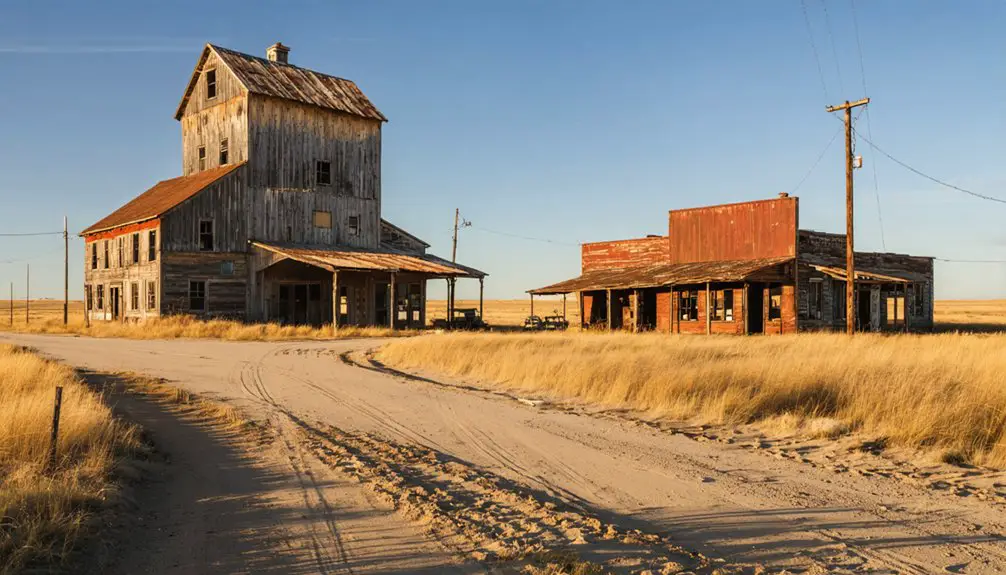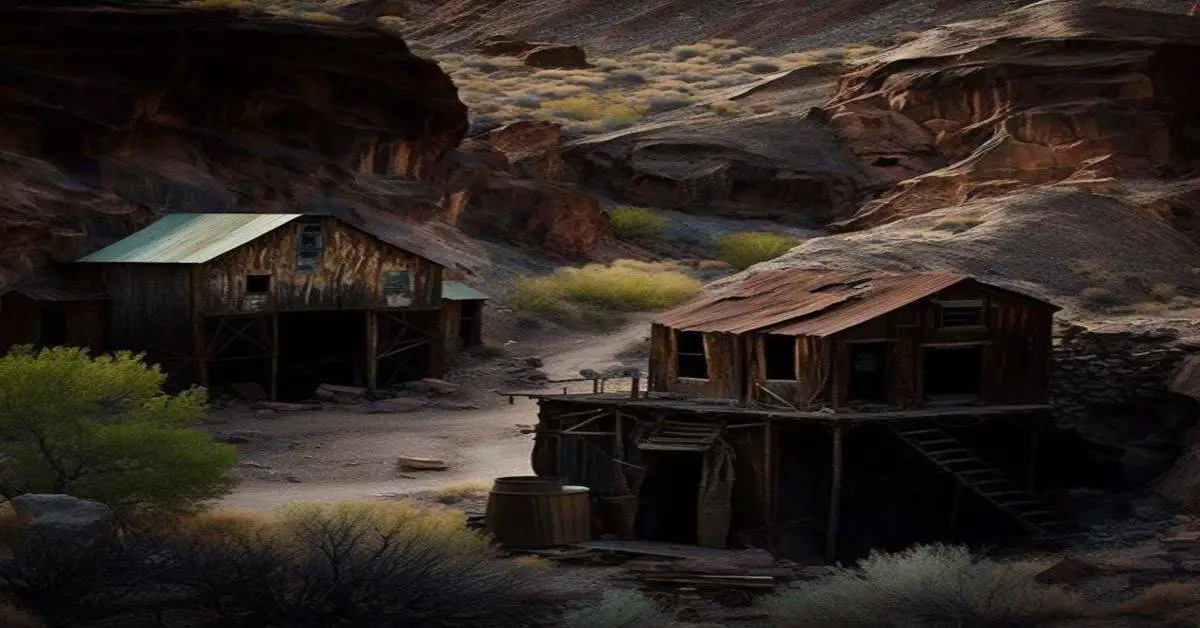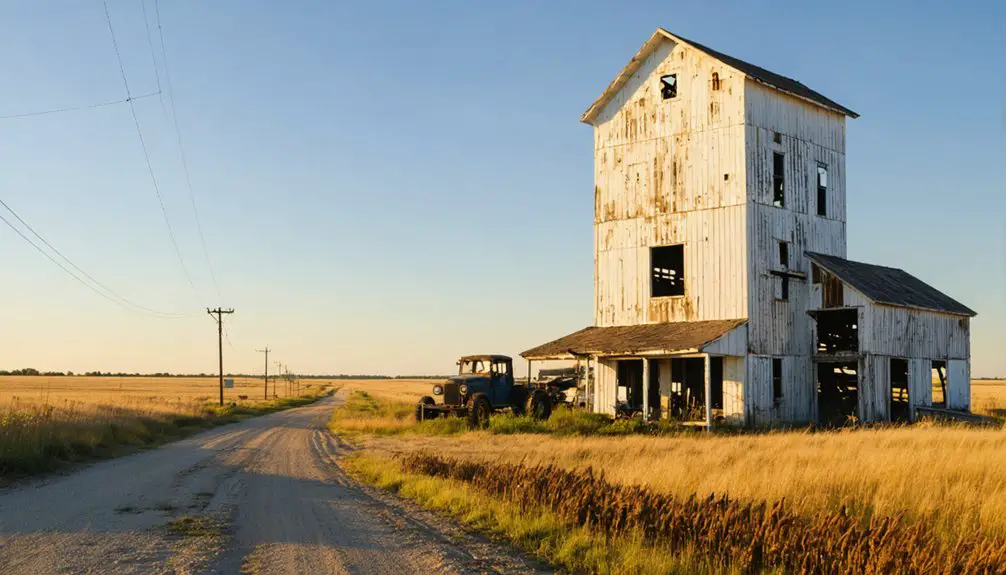You’ll find Brisbane, North Dakota in Grant County, where it emerged as a railroad town in 1911 during the region’s agricultural expansion. The settlement featured a post office, general store, blacksmith shop, and grain elevator serving local farmers and ranchers. Despite its promising start along the Northern Pacific Railway, Brisbane couldn’t survive the economic devastation of the Great Depression and Dust Bowl. Today, only farmland remains where this short-lived prairie town once stood – though its story runs deeper than empty fields suggest.
Key Takeaways
- Brisbane was established in Grant County, North Dakota in 1911 as an agricultural settlement with essential infrastructure including stores and a grain elevator.
- The town’s development was closely tied to Northern Pacific Railway operations, serving as a crucial transportation hub for agricultural shipments.
- Brisbane reached its peak population in the 1910s-1920s with fewer than 200 residents supporting local businesses and community services.
- Economic decline began during the Great Depression and Dust Bowl, leading to business closures and population loss.
- The site is now completely abandoned, with no original structures remaining and the former townsite converted entirely to farmland.
Origins and Early Settlement
During the agricultural expansion of early 20th century North Dakota, Brisbane emerged as a new settlement in Grant County in 1911.
You’ll find its settlement patterns followed the typical framework of western North Dakota farming communities, with early pioneers focusing first on livestock operations before evolving into grain agriculture.
The town quickly established itself with essential infrastructure that you’d expect in a frontier community: a post office, general store, blacksmith shop, and grain elevator.
While the naming origins of Brisbane aren’t specifically documented, it falls in line with other town names of North Dakota’s early statehood period.
The initial settlers, drawn by the promise of available land and agricultural opportunities, built their community around a main street configuration that supported both ranching and farming activities.
Like Charbonneau and over a thousand ghost towns in North Dakota, Brisbane represents the aspirations and struggles of early settlers seeking a better life.
Similar to many communities of its era, the town now stands as one of the completely barren sites listed in official records.
Railway Impact and Development
You’ll find Brisbane’s railroad story closely tied to the Northern Pacific Railway’s expansion through Dakota Territory, with the town’s station established during the branch line development era of 1880-1884.
The station served as a critical transportation hub for local agricultural shipments, connecting area farmers to broader markets through the region’s expanding rail network. The Great Northern Railway played a crucial role in agricultural development by establishing experimental farms to improve farming methods. Similar to Queensland Rail’s current operations which transport four million tonnes of freight annually, Brisbane’s rail facilities were vital for moving agricultural products.
The eventual abandonment of the track segment serving Brisbane reflected broader changes in regional transportation patterns, contributing to the town’s decline as rail service became increasingly concentrated along major trunk lines.
Railroad Station Development Era
The Northern Pacific Railroad‘s arrival in North Dakota marked a transformative era for the region’s development, beginning with its operations in 1868.
You’ll find that railroad expansion moved swiftly westward from Minnesota, reaching Moorhead by 1871 and pushing toward Bismarck by 1873. The station architecture played a vital role in establishing new settlements along the tracks. The Dakota Division operations stretched from the North Dakota/Minnesota border to Bismarck, establishing critical infrastructure. The Homestead Act advertisements by Northern Pacific helped attract settlers to these new communities.
When you explore the history of this period, you’ll discover how the railroad transformed river crossings.
Before the impressive 1,426-foot bridge was built in 1882, trains had to be ferried across the Missouri River or use temporary ice tracks in winter. The completion of this bridge connected Bismarck to Mandan, revolutionizing transportation and spurring the growth of communities that would shape North Dakota’s future.
Track Abandonment Timeline
As North Dakota’s rail network reached its zenith of over 5,300 miles in the 1920s, systematic track abandonment began reshaping the state’s transportation landscape.
You’ll find the economic repercussions were particularly severe for small communities like Brisbane, as railroads streamlined their operations through strategic track removal. Similar to the Council City Railroad in Alaska, equipment and infrastructure were often left behind after operations ceased.
Key phases of abandonment that affected the region included:
- Early cuts starting in 1936 with Milwaukee Road’s nearby segments
- Mid-century removals focusing on underutilized branch lines
- Extensive 1970s abandonments following the Burlington Northern merger
The track network ultimately shrank to about 3,600 miles, with Brisbane’s rail service eliminated as carriers concentrated on more profitable mainlines.
This loss of rail connectivity severely limited the town’s shipping capabilities and contributed to its eventual decline into a ghost town. Agricultural shipments represented the majority of freight traffic, making the loss of rail service especially devastating for local farmers.
Economic Transportation Dependencies
When railway tracks first reached Brisbane in the early 1900s, they established more than just physical connections – they created essential economic lifelines that would determine the town’s fate.
You’ll find Brisbane’s transportation evolution closely tied to the Northern Dakota Railway Company‘s efforts to serve regional cement mines and agricultural shipments. After the cement operation failed, the NDRC struggled for ten difficult years before making its final run.
The town’s economic resilience depended entirely on reliable rail service. When the NDRC struggled with undercapitalization and equipment shortages, Brisbane’s commercial activities suffered.
Without alternative transport routes, the community couldn’t sustain itself after track removal in 1922. You can trace how railway access shaped everything from settlement patterns to market connections – when the trains stopped running, Brisbane’s isolation from supply chains and agricultural markets sealed its destiny as a ghost town.
Peak Population Years
During its peak years from 1910 to the early 1920s, Brisbane, North Dakota maintained a modest but vibrant population that supported several local businesses and services.
While exact population figures weren’t officially recorded, the town’s community dynamics reflected typical population trends of small North Dakota railroad towns during this era. Much like Sherbrooke’s zero residents today, Brisbane eventually succumbed to the fate of many pioneer towns. You’ll find Brisbane’s peak size was comparable to other ghost towns like Blabon and Merricourt, likely housing fewer than 200 residents.
The town’s significance during its heyday was evident through:
Brisbane stood as a vital community hub, marked by essential businesses and services that defined small-town North Dakota life.
- A functioning post office established in 1910
- Multiple businesses including a general store, hardware store, and blacksmith
- A local school serving the town’s families
These indicators suggest Brisbane was a self-sustaining community before its eventual decline, characteristic of many rural North Dakota settlements of that period.
Community Life and Infrastructure
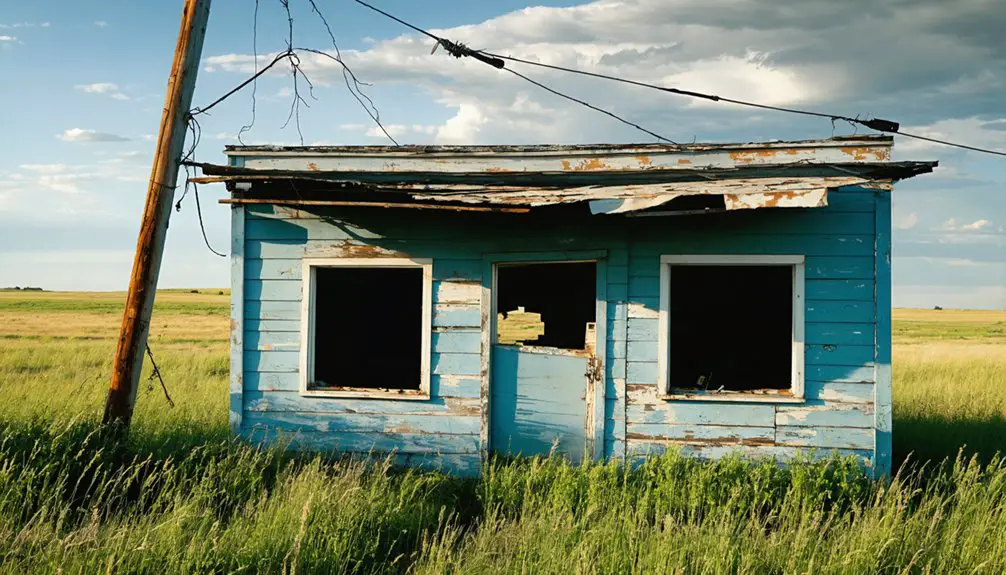
Though Brisbane’s footprint was modest, the town maintained essential infrastructure and services that supported daily life in early 20th century North Dakota.
You’d find the post office, established in 1910, serving as the communication hub where locals gathered to collect mail and exchange news. The general store and hardware shop provided necessary supplies, while the blacksmith kept farm equipment running smoothly.
Social interactions centered around the schoolhouse, restaurant, and shops, where you’d meet neighbors and discuss crops, weather, and local happenings.
Community services extended to practical matters like drainage ditches along unpaved streets to handle seasonal floods. While the railroad passed nearby, Brisbane’s location five miles southeast of Carson meant you’d rely on basic infrastructure typical of small prairie towns in Grant County.
Economic Decline and Abandonment
The decline of Brisbane’s economy accelerated when agricultural markets crashed during the Great Depression and Dust Bowl years, forcing many local farming families to abandon their land.
You’ll find that the town’s reliance on railroad connections proved insufficient to maintain economic stability as transportation patterns shifted away from small rural stops.
Brisbane’s isolation from major transport routes, combined with the severe downturn in agricultural production, created a devastating cycle of business closures and population loss that the town couldn’t overcome.
Railroad Impact Analysis
As railroad companies expanded their networks across North Dakota in the 1870s and 1880s, they wielded immense power in determining which towns would thrive and which would fade into obscurity.
You’ll find that settlement patterns directly followed rail development, with communities like Brisbane suffering when bypassed by major lines such as the Northern Pacific and Great Northern.
The impact of railroad disruptions on Brisbane’s fate was profound in several ways:
- The town’s isolation from rail service severely limited its ability to attract settlers and businesses.
- Nearby rail-connected towns drew away Brisbane’s potential population and commerce.
- Without rail access, Brisbane couldn’t compete with communities that had direct links to broader markets.
This railroad-driven economic marginalization ultimately sealed Brisbane’s fate, leading to its abandonment and ghost town status.
Agricultural Market Downturn
Beyond Brisbane’s railroad challenges, devastating agricultural market downturns in the early-mid 20th century accelerated the town’s decline into abandonment.
You’d have witnessed plummeting farm income as commodity prices fell, forcing many family farms to consolidate or fold entirely. Local businesses that once served Brisbane’s agricultural community couldn’t survive as farmers’ spending power evaporated.
The economic strain triggered widespread rural migration, particularly among young residents seeking opportunities in urban areas. Those who stayed faced mounting difficulties: closed schools, shuttered post offices, and deteriorating roads.
Environmental challenges, including drought and soil erosion, dealt additional blows to struggling farmers. The harsh realities of declining agricultural markets transformed Brisbane from a vibrant farming community into an empty prairie town, where only scattered building foundations hint at its former existence.
Remaining Structures Today
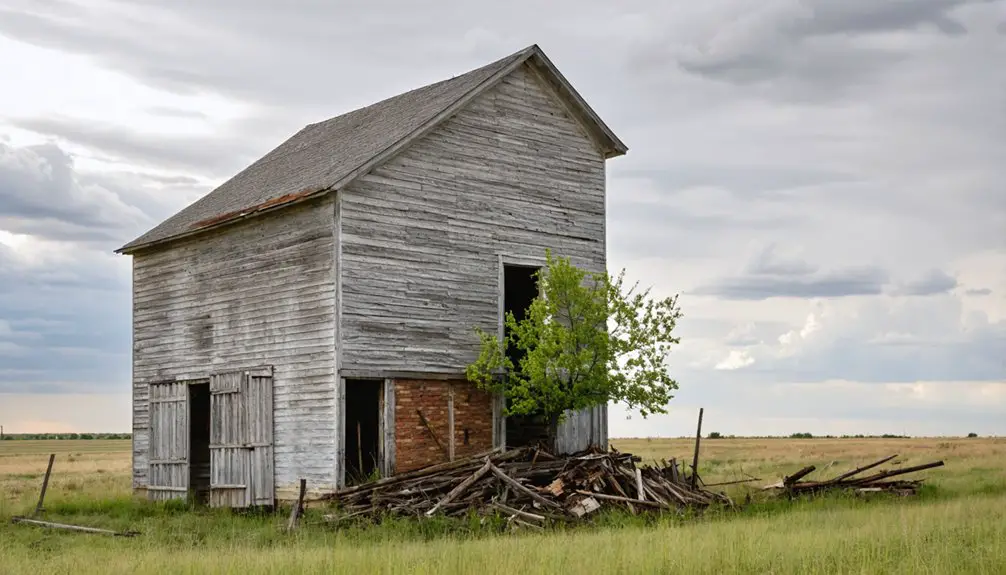
Visitors seeking remnants of Brisbane, North Dakota today won’t find a single original structure standing at the townsite.
Unlike other ghost towns in the state that still showcase historical buildings, Brisbane has been completely reclaimed by nature, with all traces of its former existence erased by time and abandonment.
If you’re hoping to explore physical remains of the town, you’ll need to adjust your expectations:
- No commercial buildings, homes, or civic structures remain
- The surrounding area consists only of farmland and natural landscape
- Even the old railroad infrastructure has vanished completely
Brisbane stands in stark contrast to ghost towns like Merricourt or Sims, where you can still find standing structures.
While other North Dakota ghost towns maintain their historic buildings, Brisbane has completely vanished without a trace.
The site offers no visible evidence of its past, making it a true ghost town in the most literal sense.
Historical Significance in North Dakota
While Brisbane’s physical remains have vanished from Grant County’s landscape, the town’s historical significance endures as a tribute to North Dakota’s early 20th-century development.
You’ll find Brisbane’s legacy woven into the broader story of rural resilience, where small communities emerged to serve the needs of isolated farming populations.
From 1910 onward, Brisbane exemplified the fundamental role that service centers played in supporting agricultural life, providing essential resources like blacksmith services, education, and basic goods to scattered homesteaders.
Despite its eventual decline, Brisbane represents a significant chapter in North Dakota’s settlement pattern, demonstrating how these small towns helped pioneer families survive and thrive in the challenging prairie environment of the early 1900s.
Preservation and Documentation Efforts

Despite Brisbane’s physical disappearance, North Dakota’s preservation agencies have worked diligently to document and protect its historical legacy. The North Dakota State Historic Preservation Office oversees these efforts through various documentation methods, while facing unique preservation challenges due to the site’s lack of remaining structures.
You’ll find several key preservation initiatives in place:
- Historical records and post office documentation maintained through county websites and archives
- Oral histories and community memories collected by local historical societies
- Video explorations and photographic documentation of the site’s current condition
While most of Brisbane’s physical structures are gone, preservation efforts continue to focus on protecting the site’s heritage through digital archives and historical research.
The NDSHPO works with local volunteers and historical groups to guarantee this ghost town’s story remains accessible for future generations.
Frequently Asked Questions
Are There Any Documented Paranormal Activities or Ghost Stories From Brisbane?
You won’t find documented ghost sightings or paranormal investigations in Brisbane’s history. While North Dakota has many haunted ghost towns, Brisbane’s records show no supernatural activity in its abandoned remains.
What Natural Resources or Mineral Deposits Were Found Near Brisbane?
With over 21 uranium deposits in western North Dakota, you’ll find calcareous shale and limestone near Brisbane’s Niobrara Formation, plus significant coal deposits, though timber resources weren’t particularly abundant in this region.
Did Any Notable Historical Figures Ever Visit or Live in Brisbane?
You won’t find any historical visitors or notable residents documented in Brisbane’s records. The town’s significance came from its role as a small railroad community rather than from famous inhabitants.
What Indigenous Tribes Originally Inhabited the Land Where Brisbane Was Built?
You’ll find the Lakota (Sioux) people’s cultural heritage deeply rooted in this land, as they were the primary Indigenous tribe inhabiting what’s now Grant County before Brisbane’s establishment.
Were There Any Significant Crimes or Notorious Incidents in Brisbane’s History?
You won’t find any documented crime statistics or infamous residents from Brisbane’s history. Available records show no significant criminal incidents, focusing instead on typical challenges of frontier settlement and eventual decline.
References
- https://northernsentry.com/2025/06/26/north-dakota-ghost-towns/
- https://www.onlyinyourstate.com/experiences/north-dakota/ghost-towns-nd
- https://www.youtube.com/watch?v=-E2DA6Ryd1g
- https://ghostsofnorthdakota892857007.wordpress.com/2015/10/30/true-ghost-towns-population-zero/
- https://northernsentry.com/2023/05/12/ghosts-of-north-dakota/
- https://writinforthebrand.com/booming-settlement-to-ghost-town-whispers-of-the-living-history-of-charbonneau/
- https://ghostsofnorthdakota892857007.wordpress.com/2017/03/28/the-story-of-how-ghosts-of-north-dakota-began/
- https://en.wikipedia.org/wiki/Ghost_town
- https://en.wikipedia.org/wiki/Railways_in_South_East_Queensland
- https://www.gnrhs.org/gn_history.php
